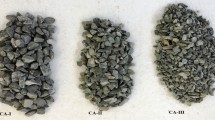Abstract
Compressive and flexural strength, fracture energy, as well as fatigue property of pervious cement concrete with either supplementary cementitious materials (SCMs) or polymer intensified, were analyzed. Test results show that the strength development of SCM-modified pervious concrete (SPC) differs from that of polymer-intensified pervious concrete (PPC), and porosity has little effect on their strength growth. PPC has higher flexural strength and remarkably higher flexural-to-compressive strength ratio than SPC at the same porosity level. Results from fracture test of pervious concrete mixes with porosity around 19.5% show that the fracture energy increases with increasing the dosage of polymer, reflecting the ductile damage features rather than brittleness. PPC displays far longer fatigue life than SPC for any given failure probability and at any stress level. It is proved that two-parameter Weibull probability function describes the flexural fatigue of pervious concrete.
Similar content being viewed by others
References
CHEN Yu, ZHANG Qi-sen, GAO Ying-li. Manufacturing technology of porous cement concrete for highway construction [J]. Road Pavement Material Characterization and Rehabilitation (Geotechnical Special Publication), 2009, 191: 22–33.
MAROLF A, NEITHALATH N, SELL E, WEGNER K, WEISS J, OLEK J. The influence of aggregate size and gradation on acoustic absorption of enhanced porosity concrete [J]. ACI Material Journal, 2004, 101(1): 82–91.
CHINDAPRASIRT P, HATANAKA S, CHAREERAT T, MISHIMA N, YUASA Y. Cement paste characteristics and porous concrete properties [J]. Construction and Building Materials, 2008, 22(5): 894–901.
NEITHALATH N. Extracting the performance predictors of enhanced porosity concretes from electrical conductivity spectra [J]. Cement and Concrete Research, 2007, 37(5): 796–804.
HUANG Bao-shan, WU Hao, SHU Xiang, BURDETTE E G. Laboratory evaluation of permeability and strength of polymer-modified pervious concrete [J]. Construction and Building Materials, 2010, 24(5): 818–823.
CHEN Yu. Study on high-performance porous cement concrete pavement for low traffic highway tunnel [D]. Changsha: Central South University, 2007. (in Chinese)
YANG Jing, JIANG Guo-liang. Experimental study on properties of pervious concrete pavement materials [J]. Cement and Concrete Research, 2003, 33(3): 381–386.
KEVERN J T. Advancement of pervious concrete durability [D]. Ames, IA, USA: Iowa State University, 2008.
SCHAEFER V R, WANG K, SULIEMAN M T, KEVERN J T. Mix design development for pervious concrete in cold weather climates [R]. Iowa Department of Transportation. National Concrete Pavement Technology Center, Iowa Concrete Paving Association. 2006.
GHAFOORI N, DUTTA S. Development of no-fines concrete pavement applications [J]. Journal of Transportation Engineering, 1995, 121(3): 283–288.
DEO O, NEITHALATH N. Compressive behavior of pervious concretes and a quantification of the influence of random pore structure features [J]. Material Science Engineering, 2010, 528(1): 402–412.
CROUCH L K, PITT J, HEWITT R. Aggregate effects on pervious Portland cement concrete static modulus of elasticity [J]. Journal of Materials in Civil Engineering, 2007, 19(7): 561–568.
SUMANASOORIYA M, NEITHALATH N. Pore structure features of pervious concretes proportioned for desired porosities and their performance prediction [J]. Cement & Concrete Composites, 2011, 33(4): 778–787.
PARK S B, SEO D S, LEE J. Studies on the sound absorption characteristics of porous concrete based on the content of recycled aggregate and target void ratio [J]. Cement and Concrete Research, 2005, 35(9): 1846–1854.
LI Q S, FANG J Q, TANG J. Failure probability prediction of concrete components [J]. Cement Concrete Research, 2003;33(10): 1631–1636.
SHENG Xin-pu, HUANG Zhi-qiang, BAO Wen-bo, CHEN Si-li. Experimental study and theory on fracture of concrete [M]. Beijing: China Waterpower Press, 2008: 131–132. (in Chinese)
ZHENG Mu-lian, WANG Bing-gang. HU Chang-shun. Study of fatigue property of porous concrete [J]. China Journal of Highway and Transport, 2004, 17(4): 7–11. (in Chinese)
Author information
Authors and Affiliations
Corresponding author
Additional information
Foundation item: Project(kfj080205) supported by Key Laboratory of Road Structure and Material of Ministry of Transport (Changsha), China
Rights and permissions
About this article
Cite this article
Chen, Y., Wang, KJ. & Liang, D. Mechanical properties of pervious cement concrete. J. Cent. South Univ. 19, 3329–3334 (2012). https://doi.org/10.1007/s11771-012-1411-9
Received:
Accepted:
Published:
Issue Date:
DOI: https://doi.org/10.1007/s11771-012-1411-9




